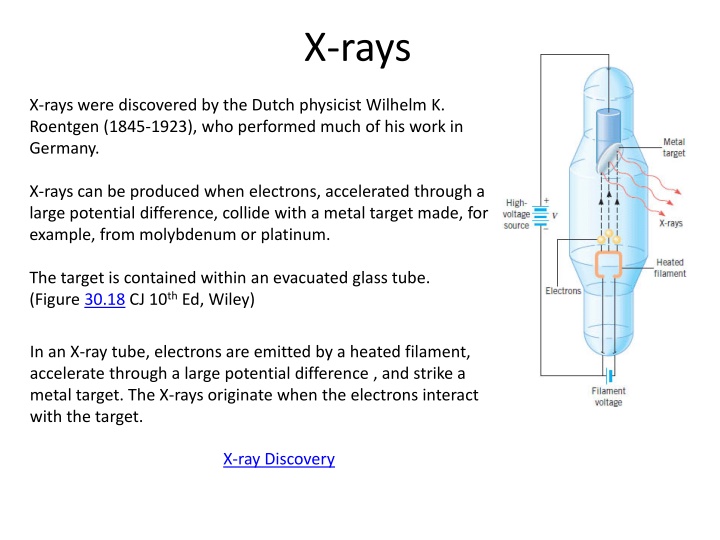
Discovering X-Rays: History, Spectra, and Moseley's Law
Explore the fascinating world of X-rays, from their discovery by Wilhelm K. Roentgen to understanding X-ray spectra and Moseley's law relating X-ray frequency to atomic number. Learn about the production of X-rays, characteristic lines, Bremsstrahlung radiation, and the extension of Bohr's theory to X-rays. Dive into Moseley's plots and calculations to determine unknown elements using X-ray frequencies. Discover the applications and implications of X-rays in various scientific fields.
Download Presentation

Please find below an Image/Link to download the presentation.
The content on the website is provided AS IS for your information and personal use only. It may not be sold, licensed, or shared on other websites without obtaining consent from the author. If you encounter any issues during the download, it is possible that the publisher has removed the file from their server.
You are allowed to download the files provided on this website for personal or commercial use, subject to the condition that they are used lawfully. All files are the property of their respective owners.
The content on the website is provided AS IS for your information and personal use only. It may not be sold, licensed, or shared on other websites without obtaining consent from the author.
E N D
Presentation Transcript
X-rays X-rays were discovered by the Dutch physicist Wilhelm K. Roentgen (1845-1923), who performed much of his work in Germany. X-rays can be produced when electrons, accelerated through a large potential difference, collide with a metal target made, for example, from molybdenum or platinum. The target is contained within an evacuated glass tube. (Figure 30.18 CJ 10th Ed, Wiley) In an X-ray tube, electrons are emitted by a heated filament, accelerate through a large potential difference , and strike a metal target. The X-rays originate when the electrons interact with the target. X-ray Discovery
X-ray Spectra The sharp peaks are called characteristic lines or characteristic X-rays because they are characteristic of the target material. The broad continuous spectrum is referred to as Bremsstrahlung (German for braking radiation ) and is emitted when the electrons decelerate or brake upon hitting the target. Molybdenum target is bombarded with electrons that have been accelerated from rest through a potential difference of 45 000 V.
Moseley's law Electrons falling to the lowest level (or K-shell) in the atom from other excited levels give out X-rays in a series of wavelengths like an optical spectrum. This is known as the K-series, and individual lines are denoted by K , K and so on. Electron transitions ending on the second level are known as the L-series. In 1914 Moseley proposed a law showing how the X-ray frequency can be related to the proton (atomic) number Z of the target material. If f is the X-ray frequency, then: X ray frequency (f) = k(Z- b)2 b = 1, for K series and b = 7.4 for L series
Moseleys Plots X ray frequency: (f) = k(Z- b)2 P1. The wavelength of the K x-ray line for an element is measured to be 0.794 . What is the element?
. Extension of Bohr Theory to X-rays http://amptek.com/xrf/
Moseleys Plots P1. Moseley pointed out that elements with atomic numbers 43, 61, 75 should exist and (at that time) had not been found. Compute the frequency of the K x-ray line for the unknown element with Z=43, and compare it with Moseley s data.
X-rays P2. The voltage across an X-ray tube is 37.0 kV. The molybdenum (Z = 42) is the target in the X-ray tube. Determine (a) the tube's cutoff wavelength (b) the wavelength of the K and x K - ray lines emitted by the molybdenum target.
